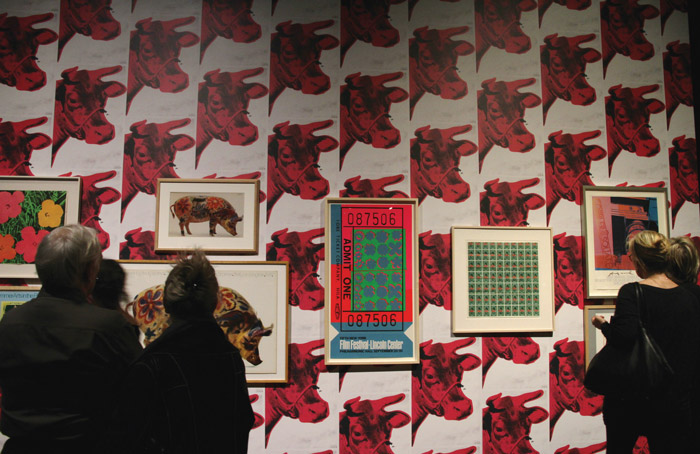With Warhol Mania, the Montreal Museum of Fine Arts (MMFA) presents an eclectic collection of Andy Warhol’s illustrations, posters, and record art—but leaves the viewer to reconcile Warhol the artist with Warhol the advertiser. Through image repetition and his typical three-colour style, Warhol’s work remains dynamic and innovative in the eyes of the modern viewer. Yet the impact of Warhol’s work relies as much on his skill as on our understanding of its cultural significance. Walking through exhibitions of Warhol’s renowned celebrity portraits along with innovative yet comparatively tentative earlier illustrations, the viewers have the sense that they are witnessing the creation of an aesthetic that still permeates today’s culture.
While Warhol’s famous images—Marilyn Monroe, Michael Jackson, Campbell’s soup—are sometimes dismissed as merely popular posters, they also represent Warhol’s contribution to the growth of celebrity culture and advertising. Indeed, much of Warhol’s work was produced with a purpose beyond the creation of art. His images were mass-produced to sell products, be it records, alcohol, beauty products, or people. In Warhol Mania, a description accompanies a striking poster of an Absolut Vodka bottle, explaining that Warhol met with the CEO of Carillon Importers—the European spirits company that produces Absolut Vodka—to create what the exhibit describes as “a ‘portrait’ of the Absolut bottle.” Warhol’s Absolut poster is not only a striking piece of artwork, but a clever marketing strategy that extends beyond Absolut. By creating a beautiful piece originally commissioned to encourage product sales, Warhol blurs the line between advertising and art.
Though Warhol created many “portraits” of objects, he is best known for his celebrity portraits and consequent contribution to our cultural fascination with celebrities. Through Warhol’s LIFE and TIME magazine covers, record art, and portraits, his visuals of celebrities permeated our culture, and have remained relevant ever since. A poster of Diana Ross for her album Silk Electric (1982) hangs in the Warhol Mania exhibit with a description that quotes Warhol. He asks, “I wonder if she wants to be black or white.” Looking at the poster, the viewer observes four captivating repetitions of Diana Ross’s noticeably pale face. As an artist, Warhol made deliberate choices concerning his work, but the wide circulation of his art as a form of advertising ensures the prevalence of his perspective, no matter what his motivations.
The extent of Andy Warhol’s influence can be traced back to the start of his career. In an issue of LIFE dating back to January 21, 1957, Warhol is described as a “commercial artist.” Though his celebrity status has increased significantly since his creation of the illustrations that accompanied that comment, this characterization remains accurate. Warhol’s artwork has universal appeal and is enduring because it symbolizes modernity and influences the present. His vivid images are amplified by the viewer’s knowledge that they are important, that they embody something greater than an advertisement, a celebrity portrait, or a beautiful illustration. Through his innovative depiction and perpetuation of American consumer products, he informs our modern understanding of art.
In his self-portrait, Andy Warhol’s yellow face stares at the viewer with penetrating eyes, which the museum description characterizes as, “infused […] with a terrifying realism.” As with any artist, we will never know precisely what Warhol intended to express through his work. Perhaps he understood that in order to bring art to a large audience, one had to reconcile art with advertising. With this portrait, Warhol does for himself what he has done throughout his career for others—portraying himself as an artist while engaging in advertising.
Warhol Mania runs until March 15, 2015 at the Montreal Museum of Fine Arts (1380 Sherbrooke Ouest). Student admission is $12, and $10 on Wednesday evenings.









